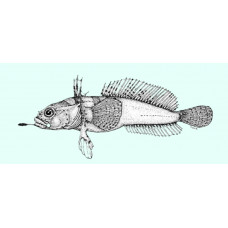Latin name
Artedidraco glareobarbatus
Identification
The genus is named in honour of the "father of ichthyology" - the Swedish ichthyologist Peter Artedi (Swedish Peter Artedi, 1705-1735). The second part of the compound word forming the genus name - Greek drako - dragon, is related to the unusual appearance of the fish's head.
Artedidraco glareobarbatus lacks an air bladder, has a chin tendril, and the skin is bare except for bony segments (scales) on the two lateral lines. In the dorsal (upper) lateral line 3-21 tubular scales (in the anterior part) and 0-15 rounded scales (in the posterior part); in the medial (middle) lateral line 9-25 rounded scales; total number of stamens in the upper part of the first gill arch 0-5, in the lower part of the arch - 10-16; total number of vertebrae 33-41. Head relatively small, slightly compressed at the sides. There are no spines on the genal and subgenal bones. Post-temporal bony ridges on the top of the head are not prominent. The snout is shorter than the horizontal diameter of the orbit. The interorbital space is very narrow. The teeth on the jaws are small, bristly, numerous and arranged in several rows. There are two lateral lines: a dorsal line with tubular and rounded segments and a medial line with rounded segments.
Features of fish fins
The first dorsal fin has 2-7 soft barbs, the second dorsal fin has 23-30 rays, the anal fin has 14-19 rays and the pectoral fin has 16-22 rays. The first dorsal fin is located above the base of the pectoral fin.
Fish colouring
The colouration of fish in this family can include eye spots on the caudal fin and camouflage of the true eyes.
Distribution
They are endemic to the high-latitude zone of the Southern Ocean and are found in the Ross Sea of Antarctica, mainly at relatively shallow shelf depths.
Habitat
A marine bottom-dwelling polar species, with a habitat depth range of 107 to 287 m.
Size
They are small fish with a total length of no more than 16 cm.
Behavior
They are a relatively new species of fish and their lifestyle is virtually unstudied.
Food and feeding habits
Typically zoophagous benthic. The diet consists mainly of polychaetes and various bottom and benthic crustaceans. These fish have a tendril with a peculiar structure, apparently used by the external olfactory organ to locate sessile bottom feeders.
Reproduction
Spawning is single. Breeds during the summer in the southern hemisphere. Males guard a clutch of ground eggs.
Fishing
May be present in coastal bottom trawl fisheries.
Relationship with a person
Harmless.
| Classification | |
| Phylum | Chordata |
| Class | Actinopterygii |
| Squad | Perciformes |
| Family | Artedidraconidae |
| Genus | Artedidraco |
| Species | A. glareobarbatus |
| Features | |
| Conservation status | Least Concern |
| Habitat | Bottom |
| Life span, years | No information |
| Maximum body weight, kg | No information |
| Maximum length, cm | 16 |
| Sailing speed, m/s | No information |
| Threat to people | Edible |
| Way of eating | Bentophage |

